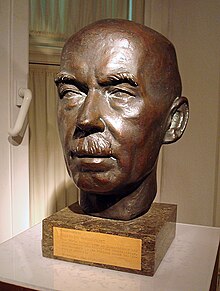Paul Westerfrölke

Paul Westerfrölke (born February 24, 1886 in Gütersloh , † March 27, 1975 there ) was a German painter , graphic artist , conservationist and ornithologist .
Life
Paul Westerfrölke was the son of the businessman and hotelier Wilhelm Westerfrölke and his wife Luise, née Barkey. After graduating from high school in 1904, Westerfrölke attended the Düsseldorf School of Applied Arts (1905–1908), where he was particularly interested in nature studies, and plant and animal drawings. In 1908 he moved to the Düsseldorf Art Academy , where he made human, animal and landscape studies with Carl Ederer . In 1912 he was able to sell pictures for the first time. In 1914 he was a master student with his own studio.
Westerfrölke u. Did his military service in the First World War . a. in Minden , Lille and Allenstein . In 1915 he was given leave of absence for one year due to incapacity. During this time he did advanced training at the Berlin Art School, followed by a drawing teacher exam. After the war he moved to Gütersloh in 1919. In 1935 he received the Cross of Honor of the World War .
In 1925 Westerfrölke became a member of the Association of Westphalian Artists . From 1933 the prices of his pictures rose and he was able to win orders for cover illustrations for national newspapers. In 1934 he became a member of the Free Artist Community Schanze in Münster. In 1936 he painted the painting "Westphalian Farm" for the boardroom of the senior executive committee in Münster. In 1938 pictures of him were shown at the art exhibition as part of the Gütersloh “Michaeliswoche” (folk festival and business exhibition); The curator was Otto Winkelsträter . 26 Westerfrölke pictures were shown at the Great German Art Exhibitions in Munich from 1937 to 1943.
Apart from his studies and the short military service, Westerfrölke spent his entire life in Gütersloh. In 1937 he turned down a call to the Academy of Applied Arts in Munich, where he was supposed to take over the graphics class (his planned takeover of the graphics class at the Münster Art Academy prevented the beginning of the war in 1939); Instead, Westerfrölke made painting his profession in Gütersloh and gained fame above all as a native draftsman of Westphalia. In Dressler's art manual from 1928 he is referred to as the “painter of the heath”. He also exhibited abroad, which made his works known beyond the borders of his hometown. According to his own statements, Westerfrölke understood his landscape drawings less as painting, but rather as “depictions of landscapes”. Today his pictures and drawings are mostly in private hands.
In addition to his artistic work, Paul Westerfrölke was also active as a conservationist and ornithologist and was considered a proven expert on the local bird world. After his death, his precise and comprehensive records were transferred to the Natural History Museum in Münster for analysis . Westerfrölke acquired his knowledge autodidactically through his own observations and intensive literature study. In 1935 he was appointed landscape officer (nature conservation warden) or district commissioner for the Wiedenbrück district . Westerfrölke carried out this office until shortly before his death and thus also for the Gütersloh district, which was newly established in 1973 . Between 1965 and 1969 he mapped more than two thirds of the bird species native to the district. Westerfrölke was an active member of the “Natural History and Nature Conservation” department in the Westphalian Heimatbund for many years . In 1961 he was awarded the Federal Cross of Merit for his services to nature conservation .
Paul Westerfrölke died at the age of 89 from a heart attack that he suffered while working in the garden at home.
reception
In the year of his death, citizens of Gütersloh suggested naming a street after Paul Westerfrölke. In 1980, the Heimatverein applied for the naming of the as yet unnamed hiking trail along the Dalkepromenade after him. Today the Paul-Westerfrölke-Weg runs for around three and a half kilometers from the city center to the Neue Mühle, east of the Pavenstädt district .
In 2013 the Gütersloh City Museum showed a selection of works under the title “Heimat - Bilder” , together with pictures by Otto Winkelsträter .
literature
- Joseph Peitzmeier : Paul Westerfrölke as a nature observer , Gütersloher Contributions, issue 54/55, June 1979
- Heimatverein Gütersloh: From Westerfrölkes workshop , edited by Karsten Kelberg, Gütersloh 2000
- Paul Westerfrölke 1886 - 1975 , booklet for the exhibition of the cultural office of the city of Gütersloh in cooperation with the Kunstverein Kreis Gütersloh eV, the Galerie Friedemann and Antiquitäten Jentsch in Gütersloh on the 100th birthday of Paul Westerfrölke
- Stephan Grimm, Heinrich Lakämper-Lührs: Gütersloher write history , Verlag Wartberg 2005, ISBN 3-8313-1588-4
Individual evidence
- ↑ a b The Paul-Westerfrölke-Weg, website of the city of Gütersloh
- ^ Street name project of the Elly-Heuss-Knapp-Schule Gütersloh ( Memento from December 3, 2013 in the Internet Archive )
- ^ Stadtmuseum Gütersloh: Heimat-Bilder. Otto Winkelsträter and Paul Westerfrölke
| personal data | |
|---|---|
| SURNAME | Westerfrölke, Paul |
| BRIEF DESCRIPTION | German painter, graphic artist, conservationist and ornithologist |
| DATE OF BIRTH | February 24, 1886 |
| PLACE OF BIRTH | Gutersloh |
| DATE OF DEATH | March 27, 1975 |
| Place of death | Gutersloh |